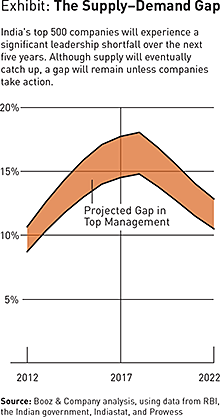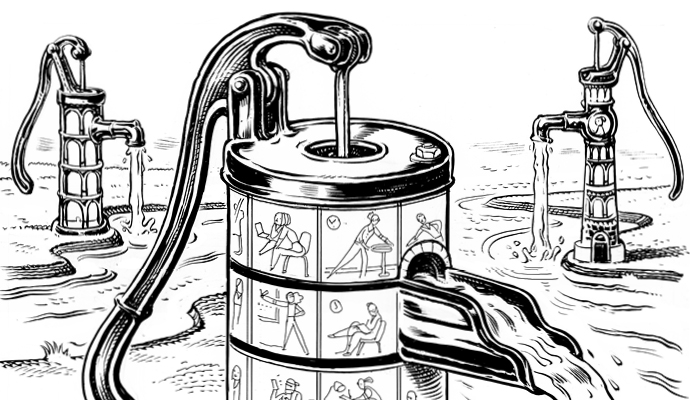India’s Leadership Challenge
At many Indian companies, the development of top management has lagged behind the pursuit of technical excellence.
A significant number of Indian companies have experienced impressive growth during the past two decades. But today, many face a daunting side effect: a nationwide crisis in leadership. In some ways, Indian companies are victims of their own success. As one senior HR manager at a large private-sector conglomerate explained, “People have been so focused on growth that they have not invested in developing [the next generation of executives]. There is a strong circle of top leadership in our businesses, but no tag team.”
Recent survey data supports this claim. In a 2010 study by Harvard Business Publishing, an overwhelming 88 percent of top Indian companies cited “gaps in [their] leadership practice” as their top challenge in coming years. The 2012 ManpowerGroup Talent Shortage Survey, a global survey of employers, reported that 48 percent of respondents based in India had difficulty finding qualified candidates for their senior managerial positions. And Booz & Company (the publisher of strategy+business) forecast in a recent in-depth analysis of India’s top 500 companies that by 2017, 15 to 18 percent of leadership positions in those companies will be unfilled—or will be filled by people underprepared for the jobs. This implies that companies will be missing almost one of every five leaders they need, putting both potential growth opportunities and the continuity of existing business operations at risk (see Exhibit).
Several underlying causes have contributed to this breakdown in India’s corporate leadership pipeline. Considered together, they explain how Indian companies have arrived at their current precarious position. Understanding these factors can reveal the opportunities that today’s senior executives can use to set things right. It can also provide helpful insight to executives in other emerging economies, many of whose companies are also suffering from a senior executive talent shortage.
Shifting Realities
About 65 percent of India’s 1.2 billion people are between 15 and 64 years old, and 30 percent of the population is made up of those younger than 15. This widely recognized “demographic dividend” should have given Indian companies a significant advantage in the form of a sizable pool of qualified applicants. But the country’s youth-dominated population has thus far fallen short of its promise. Nandan Nilekani points out in his book Imagining India: The Idea of a Renewed Nation (Penguin, 2009) that India lacks the educational institutions it needs, from the earliest years to the post-college level. Thus, even though thousands of Indian university graduates enter the workforce every year, they are often not “industry ready” or equipped in the skills of global business. This has contributed to a dearth of topnotch candidates and a growing talent war for those few with desirable skill sets.
Young talent needs development and supervision. And as Indian companies have expanded their reach both domestically and abroad, the lack of managers capable of providing this guidance has become more acutely felt. The founding executives who built these thriving businesses, and who made the far-reaching strategic decisions in the past, are now approaching retirement. According to the chief executive of a large private-sector financial-services company in India, the country’s economy is growing at a faster pace than the rate at which the leadership pipeline is maturing. A decade of rapid expansion and exponential growth has left companies in deep need of talent that is in short supply.
This dynamic is all the more daunting because operating models at many Indian companies have shifted. Traditionally, Indian companies operated in a markedly top-down manner—the person with the corner office made the final decisions, and senior managers oversaw their specific silos. That top-down model was efficient, but it stifled creativity and discouraged autonomous decision making. Now it is giving way to a more participative approach, more resonant with the younger generation and more effective for companies that are too big to micromanage. But this new operating model can be effective only if skilled managers are available to fill the ranks.
Looking for Leaders
India’s young, underprepared population, its rapid economic growth, and its changing business models are the most visible contributors to its leadership deficit. But there is a subtler yet equally powerful underlying cause: Historically, Indian business leaders have focused on developing technology rather than people. As a senior manager at a large Indian conglomerate put it, “We have quality technical experts, but can’t convert them into business leaders.”
Perhaps the most obvious example occurs in the C-suite: Few companies have provided human resources a seat on the executive management committee. As a result, the HR department often has a limited role (or no role) in the strategic planning process, leading to a lack of focus on people matters. As U.S. companies did in the early years of the Silicon Valley boom, Indian companies have prioritized achieving technical excellence, hiring engineers who’ve been trained to pursue innovation—but not to manage people and lead organizations. Evidence of this dynamic can be found in practices prevalent throughout Indian companies.
Insufficient training for new recruits. Many Indian companies struggle with new-hire “onboarding” programs. Often, the incoming class of MBA recruits is not sufficiently integrated into the broader workforce, and companies put too much hope too early on these new hires’ shoulders.
Meanwhile, rotation programs meant to train the new recruits are often ill conceived and seen by line managers as an intrusion into daily work. “Corporate has assigned two MBAs to my department for rotation—I don’t know what to do with them,” said a department head at one midsized Indian company. “My people are already overworked with their routine work. We do not have the time to train these overpaid young recruits.”
Limited variety of experience at the top. Without a strong leadership pipeline in place, star functional specialists are typically promoted to top roles. These individuals may have a background focused within one domain, and may not have had the opportunity to develop a broader perspective or set of skills.
This experience gap is not a problem just for Indian companies; it is endemic to corporate structures everywhere. Many global companies compensate with targeted on-the-job experiences and in-depth training, where they bring senior executives together to help develop one another’s skills. But Indian companies have invested little in this type of executive development. Thus, when functional specialists are promoted into general management positions, few are well prepared and motivated to handle their new roles.
A lack of succession planning. Rapidly growing industries, such as those driven by the rise of digital media, often rely on relatively young and inexperienced managers to take on senior positions. By and large, these individuals have not yet developed a leader’s perspective. For example, the telecom boom over the past decade has led to a flurry of flourishing mobile phone brands in India. But each of these firms has had to draw upon the company’s existing pool of players to build its senior team. The growth of that talent pool has not kept pace with those of the brands. One regional sales head for a mobile handset company pointed out that “eight to 10 years ago, there were only three or four handset brands in the country. Today, there are over 60. Relatively younger managers have had to step up to take on top roles in these companies.”
The ultimate result of this lack of qualified successors? Senior leaders are postponing retirement. Instead of developing and executing a clear succession plan, executives have been extending their tenure, lacking confidence that the next level of management is up to the task of leading.
The Next Generation
Many Indian executives recognize the challenges, but are unsure what steps to take to overcome them. First and foremost, they need to take a fresh, holistic look at their leadership development practices. Their goal should be to develop a sustainable leadership pipeline throughout the organizational pyramid: a well-rounded leadership team to complement the required skills at the top, a team of successors right behind them, a strong bench of high-potential individuals identified and developed in the middle, and a cadre of young, industry-ready talent. The pipeline should also include advancement opportunities for technical specialists.
This is no small task, and will require executives and managers to embrace the idea that training young recruits is an essential part of their routine, and will provide the incentives for them to contribute to the organization. Companies will need to invest in replicating and implementing specific interventions that have been successful at global companies (and a small number of Indian companies), instead of generic initiatives. This means making talent management a key component of HR strategy, and making HR a key participant in the firm’s decision-making processes.
By taking these steps, companies can fill their immediate gaps while building the enterprise capabilities necessary to ensure that they thrive in the long run. But only in companies whose leaders endorse this approach wholeheartedly, and where it can become ingrained in the company’s culture, will such changes take hold. Talent is India’s greatest opportunity, but it is also one of its biggest challenges. The same is true for more and more businesses in other developing regions around the world. In each of them, it falls to today’s executives to ensure strong leadership for generations to come. ![]()
Reprint No. 00178
Author profiles:
- Gaurav Moda is a principal with Booz & Company’s organization, change, and leadership practice, and is based in New Delhi.
- Anshu Nahar is a senior associate with Booz & Company’s organization, change, and leadership practice, and is based in Mumbai.
- Jai Sinha is the co-head and managing director of Booz & Company in India, and is based in Mumbai.




